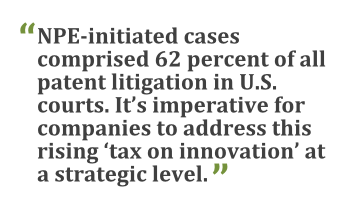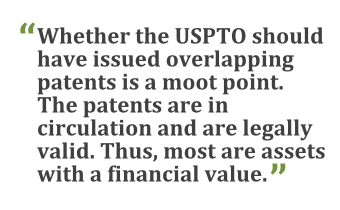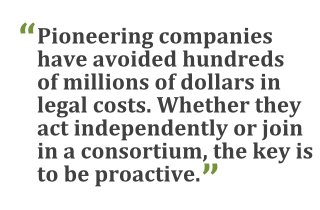 By now, most directors and executives have heard of patent lawsuits being filed by non-practicing entities (NPEs)—more commonly known as “patent trolls.” These are companies that own patents but do not use those patents to produce products or provide services. Instead, these entities are in business solely to collect licensing fees or legal settlements from the patents they own. They pursue these outcomes through litigation or the threat of litigation, against businesses whose products or services allegedly infringe on the patents.
By now, most directors and executives have heard of patent lawsuits being filed by non-practicing entities (NPEs)—more commonly known as “patent trolls.” These are companies that own patents but do not use those patents to produce products or provide services. Instead, these entities are in business solely to collect licensing fees or legal settlements from the patents they own. They pursue these outcomes through litigation or the threat of litigation, against businesses whose products or services allegedly infringe on the patents.
Although the concept of patent trolls may be familiar, few members of the C-suite recognize just how large and costly a problem these businesses have become. In 2012 alone, the cost of NPE-generated litigation was nearly $11 billion, according to a recent study conducted by RPX, in collaboration with the Coalition for Patent Fairness. More than 2,400 unique companies faced at least one NPE assertion of patent infringement last year, and 270 companies fought three or more NPE lawsuits. Clearly, patent risk has become a serious strategic and operational risk.
Nevertheless, most companies continue to treat patents and patent litigation purely as the province of the legal department. They are relying on legal tactics to solve what has become a market problem. For risk managers at all operating companies that sell or use technology products or services, the time is ripe for a radical shift in thinking. It's time to insist that patents become a more integral part of the company's overall risk-mitigation planning.
Threat of Counter Suits Deters Some Patent Litigation
The rise of NPE risk reflects the explosion in technological innovation over the past two decades. As new digital technologies have emerged and become widely adopted, the United States Patent and Trademark Office (USPTO) has seen a steadily rising flood of new patent applications. For reasons too complex to explore here, that agency has approved and issued a large number of these patents—more than 2 million since 2000. Many of these patents are ambiguously or poorly worded, and many contain claims that overlap with previously issued patents. As a result, there are quite a few patents in circulation today that could plausibly be seen as being infringed by existing products and services.
This is not as dire a situation as it might at first appear to be. While almost all technology companies now own patents that are arguably being infringed, it turns out that patent-infringement claims between operating businesses remain relatively rare. (The recent Apple-Samsung litigation is a notable exception.) Most companies are not in the business of copying their peers; product strategies are usually built on progressive innovation rather than on purposeful imitation. Therefore, for most organizations, fighting to protect yesterday's technology advantage is not a priority. They see legal battles over patents that are no longer cutting-edge as a wasteful distraction in fast-moving tech markets.
Equally important, most operating companies maintain large and broadly applicable patent portfolios—as do their competitors. It is understood that a technology business will almost certainly answer a claim of patent infringement with a counter claim that one of the plaintiff's products is itself infringing on a patent owned by the defendant. Remember, the profusion of patents has made infringement an entirely plausible argument in recent years. Most companies have accepted the status quo, in which the threat of “mutually assured destruction” usually prevents devastating patent fights.
However, although this equilibrium helps keep the peace among operating companies, it offers no deterrent to claims of patent infringement by NPEs, whose entire business model is built around acquiring patents and then asserting infringement to generate licenses or settlements from the accused businesses. Because NPEs do not make products or sell services, they're unlikely to fear counter suits claiming they've infringed on the defendant company's patent portfolio.
NPEs Create a “Tax on Innovation”
The impact of NPEs has grown rapidly. As recently as 2006, approximately 1,000 U.S. businesses a year were defendants in an NPE litigation. By 2011, that number had grown to almost 3,000 separate operating companies—and NPE-initiated cases comprised 62 percent of all patent litigation in U.S. district courts. Today, there are nearly 800 active NPEs in the United States, and they have an estimated collective capitalization of more than $8 billion.
The rapid and sustained growth of NPE litigation has made it a priority for corporate executives and risk managers. Every dollar spent defending against an NPE assertion is a dollar not spent on research and development, market development, or job creation. It's imperative for companies to address this rising “tax on innovation” at a strategic level.
The first step in establishing an effective strategy for mitigating patent risks is for operating companies to accept that patents are assets. Whether the USPTO should have issued so many overlapping patents is a moot point. The patents are now in circulation, and unless a legal battle proves them otherwise, the patents are legally valid intellectual property. Thus, most are assets with a financial value. The alleged users of those assets (in other words, operating companies that incorporate the patented technology into their products or services) may need to pay the owners (in many cases, NPEs) for that usage.
This is not a far-fetched notion. In point of fact, fully 95 percent of NPE patent litigations settle before a verdict. In other words, 95 percent of the time, operating companies agree to pay for their use of the patent asset. It is a classic exchange of value. Unfortunately, NPEs have built a business model that relies on the legal system to effect this exchange, and it is hard to imagine a more costly and less efficient mechanism for exchange of value than litigation. Of the $11 billion in total NPE costs borne by operating companies in 2012, fully half were legal costs; the other half comprised settlements and license payments.
A Market Solution to a Market Problem
Corporate decision-makers should be seeking market-based, rather than legal, solutions to NPEs' assertion of patent rights. Not all market solutions, however, are created equal. Some are more effective than others at mitigating the impact of NPE litigation. 
The simplest market solution may be for individual companies to deploy their own capital to preemptively acquire patents that represent a risk of litigation. However, this strategy of unilateral acquisition has several drawbacks. It is enormously expensive; for the reasons explained above, there can be hundreds or even thousands of patents that read on a company's products or services. This approach is also very inefficient, putting 100 percent of the financial burden of clearing a patent on a single company, even when the patent represents a litigation risk to dozens or even hundreds of other companies. This is the so-called “free rider” problem.
A related approach is to form a small patent-buying consortium. These have generally comprised companies with similar product technology profiles. They have had some success. A consortium enables participating companies to efficiently share the cost of patent acquisition. It simultaneously overcomes the free-rider problem to some degree, although the limited size of most consortiums means that non-participating companies usually benefit when a consortium buys a patent. The biggest challenge of a consortium scenario is that buying decisions are often difficult because the amount of capital available for patent acquisitions may be constrained and each patent purchase requires a unanimous vote. (Every patent does not represent the same degree of risk to every company.)
A third option for dealing with NPE risk is to eschew pre-emptive buying altogether and instead deploy capital on legal defense. Some companies have adopted this “fight hard” strategy in the belief that if they gain a reputation as expensive and time-consuming to sue, they will discourage NPEs from naming them in future litigation. There is little evidence, however, that this strategy has the desired effect. From 2008 to 2011, average growth rate of case loads for defendants in NPE cases was 36 percent, and the growth rate was the same for companies that settled quickly as for those that remained in litigation for more than a year.
Intelligence in a Large-Scale Network
One market-based approach that has proven effective is creating a large-scale network that pools capital and enables members to share equally in ownership of acquired patents, but leaves acquisition decisions to an independent third party. Such a network can overcome the logistical hurdles of a consortium and, because of its scale, can limit the free-rider problem. And if it achieves sufficient scale, it may be able to effectively acquire high-risk patents before NPEs can buy them.
 The large-scale network model also has the advantage of market intelligence. The more one knows about patent and litigation costs, the more effectively one can negotiate acquisitions and settlements. And if all market participants have trustworthy information about the patents they own and the costs of monetizing them, there should be a steady movement away from litigation as a tool for exchanging patent value. As the equities, real estate, and commodities markets indicate, a more transparent market is a more efficient market.
The large-scale network model also has the advantage of market intelligence. The more one knows about patent and litigation costs, the more effectively one can negotiate acquisitions and settlements. And if all market participants have trustworthy information about the patents they own and the costs of monetizing them, there should be a steady movement away from litigation as a tool for exchanging patent value. As the equities, real estate, and commodities markets indicate, a more transparent market is a more efficient market.
At RPX, we believe this is the inevitable long-term trend in the patent market, and we have seen it gain traction in our business. More and more patents are being managed without litigation, and a growing number of companies are proactively addressing the NPE threat, rather than waiting for the next assertion letter. The rise of defensive networks and syndicated acquisitions is allowing companies to collectively, and far more efficiently, reduce the cost and risk of NPE litigation.
These are positive trends, and pioneering companies have already avoided thousands of litigations and hundreds of millions of dollars in legal costs. Nonetheless, the tax on innovation remains too high. Companies facing NPE risk—and this is rapidly becoming every company that uses or incorporates technology in its products—can do more. Whether they act independently or join in a broader consortium, the key is to be proactive. Doing so can help redirect the “tax” they might pay to NPEs back into innovation.
———————————————
 Ned Segal is chief financial officer of RPX Corporation, a leading provider of patent risk management solutions. Founded in 2008, the firm has invested more than $700 million in acquiring potentially problematic patents in the open market or out of litigation that would otherwise be used offensively against its clients. The firm also executes large-scale syndicated transactions, provides innovative NPE litigation insurance, and delivers in-depth market intelligence and strategic advisory services to the 160 members of its growing client network.
Ned Segal is chief financial officer of RPX Corporation, a leading provider of patent risk management solutions. Founded in 2008, the firm has invested more than $700 million in acquiring potentially problematic patents in the open market or out of litigation that would otherwise be used offensively against its clients. The firm also executes large-scale syndicated transactions, provides innovative NPE litigation insurance, and delivers in-depth market intelligence and strategic advisory services to the 160 members of its growing client network.
© 2025 ALM Global, LLC, All Rights Reserved. Request academic re-use from www.copyright.com. All other uses, submit a request to [email protected]. For more information visit Asset & Logo Licensing.




